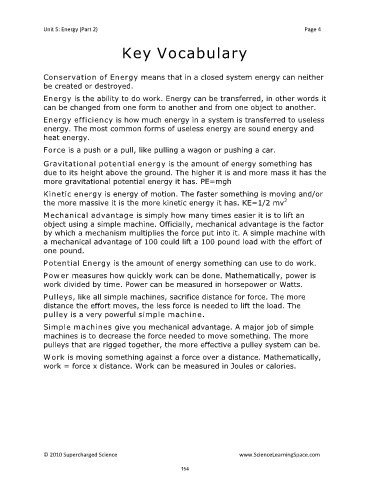Page 154 - Microsoft Word - LessonPlan-Overview.doc
P. 154
Unit 5: Energy (Part 2) Page 4
Key Vocabulary
Conservation of Energy means that in a closed system energy can neither
be created or destroyed.
Energy is the ability to do work. Energy can be transferred, in other words it
can be changed from one form to another and from one object to another.
Energy efficiency is how much energy in a system is transferred to useless
energy. The most common forms of useless energy are sound energy and
heat energy.
Force is a push or a pull, like pulling a wagon or pushing a car.
Gravitational potential energy is the amount of energy something has
due to its height above the ground. The higher it is and more mass it has the
more gravitational potential energy it has. PE=mgh
Kinetic energy is energy of motion. The faster something is moving and/or
2
the more massive it is the more kinetic energy it has. KE=1/2 mv
Mechanical advantage is simply how many times easier it is to lift an
object using a simple machine. Officially, mechanical advantage is the factor
by which a mechanism multiplies the force put into it. A simple machine with
a mechanical advantage of 100 could lift a 100 pound load with the effort of
one pound.
Potential Energy is the amount of energy something can use to do work.
Power measures how quickly work can be done. Mathematically, power is
work divided by time. Power can be measured in horsepower or Watts.
Pulleys, like all simple machines, sacrifice distance for force. The more
distance the effort moves, the less force is needed to lift the load. The
pulley is a very powerful simple machine.
Simple machines give you mechanical advantage. A major job of simple
machines is to decrease the force needed to move something. The more
pulleys that are rigged together, the more effective a pulley system can be.
Work is moving something against a force over a distance. Mathematically,
work = force x distance. Work can be measured in Joules or calories.
© 2010 Supercharged Science www.ScienceLearningSpace.com
154

